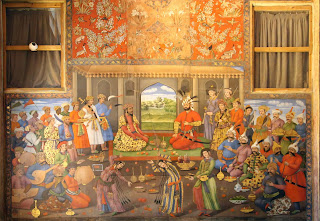The Workshop on Medieval Indian Paintings by Shriya Gautam
Or shall we call it, The Second Half of the Workshop on Coinage? I am very Shakespearean about names. What's in a name after all? I am sure the whole thing would still be a workshop on Medieval Painting even if it happened right after we finished working with those gorgeous coins.
So, there we were, still at The Rumour Mill, fed and watered and finally ready to start working on the gorgeous Basholi and Kangra Paintings, Speaking Archaeologically had been lucky enough to procure from private collections.
Now to say that those paintings were a work of art is an understatement! The phrase"work of art" doesn't even begin to describe the intricate brushwork and the gorgeously innovative use of molten gold and silver for painting, that these paintings employed so heavily.
I suppose, I cannot leave a bit of the history of these paintings out , if I have to do justice to what we did on the workshop. So, basically, the miniature painting art in Medieval India was a result of the Mughal (Mogul, for our English friends) Emperor, Humayun's exile in the court of Shah Tahmasp I of Persia, from where he brought in two very talented painters. The precursor to all this, thus, was the Mughal School of Paintings which focused on portraits, hunting and war scenes, scenes from myths and legends and basically everything under the sun, including the sun itself.
When the Mughal power declined, the painters of the Mughal School were taken under the Rajput Wing, and hence the eventual birth of the two schools of art we studied that day:
The Basholi School of Art
This School of Art emerged in the Kathua district of the Northern State, Jammu and Kashmir and dealt mostly with the dull grey and yellow colours, portraying a vast array of religious themed paintings.
Our Volunteer, Athira Jamwal, who hails from that region, and eventually worked with the Paintings Section of the Chandigarh Museum and Art Gallery, for a task, was more of an expert on this baby here, than I was.
Interestingly, Basholi art still flourishes, making it the only Medieval Miniature School of Art that still thrives in India.
The Kangra School of Art
This was yet another school of art, that developed in the Kangra region of Himachal Pradesh and dealt with extensive use of colour as well as that gold and silver paint I mentioned earlier.
This particular piece was extremely hard for us to examine because of its fragility and age. You wouldn't want to damage something so gorgeous and historic, would you?
I remember feeling ready to drop down dead with exhaustion as I finished talking about the specific features, history and techniques involved in making these paintings and honestly what kept me going was the level of enthusiasm among these incredibly passionate people.
Not so much as an exhausted sigh, no sir!
Archaeology is fun to teach when you are met with enthusiasm. It's even more fun when you have Volunteers like these, who want to research,not just because it looks great on their CVs but also because it offers them something new to learn. I think, Speaking Archaeologically validates its existence in people like these, who are inspired and charged and passionate about what they do. Which is why, coming up with new tasks and new workshops for them is never so much work for us as it is fun.
Now to say that those paintings were a work of art is an understatement! The phrase"work of art" doesn't even begin to describe the intricate brushwork and the gorgeously innovative use of molten gold and silver for painting, that these paintings employed so heavily.
 |
| Humayun, in the court of Shah Tahmasp I |
When the Mughal power declined, the painters of the Mughal School were taken under the Rajput Wing, and hence the eventual birth of the two schools of art we studied that day:
 |
| The Basholi School of Art |
The Basholi School of Art
This School of Art emerged in the Kathua district of the Northern State, Jammu and Kashmir and dealt mostly with the dull grey and yellow colours, portraying a vast array of religious themed paintings.
Our Volunteer, Athira Jamwal, who hails from that region, and eventually worked with the Paintings Section of the Chandigarh Museum and Art Gallery, for a task, was more of an expert on this baby here, than I was.
Interestingly, Basholi art still flourishes, making it the only Medieval Miniature School of Art that still thrives in India.
 |
| The Kangra School of Art |
This was yet another school of art, that developed in the Kangra region of Himachal Pradesh and dealt with extensive use of colour as well as that gold and silver paint I mentioned earlier.
This particular piece was extremely hard for us to examine because of its fragility and age. You wouldn't want to damage something so gorgeous and historic, would you?
I remember feeling ready to drop down dead with exhaustion as I finished talking about the specific features, history and techniques involved in making these paintings and honestly what kept me going was the level of enthusiasm among these incredibly passionate people.
Not so much as an exhausted sigh, no sir!
They had their gloves on, their eyes open, charged with caffeine
and their notepads at the ready.
Who wouldn't want to spend more time with such enthu-cutlets?




Comments
Post a Comment